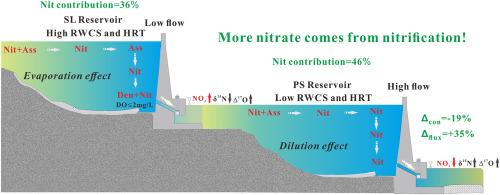人工调节通过改变水文条件影响梯级水库中硝酸盐的来源和转化
IF 8.4
2区 环境科学与生态学
Q1 ENVIRONMENTAL SCIENCES
引用次数: 0
摘要
水库被认为是硝酸盐循环的关键地带,它极大地改变了河流系统中硝酸盐的源汇动态。然而,人工调控引起的水文变化对梯级水电站水库硝酸盐来源和转化过程的影响尚不清楚。为此,研究了吴江梯级水库硝酸盐浓度、δ15NNO3、δ18ONO3、δD、Δ17OH2O、相对水柱稳定性(RWCS)、径流及相关环境因子的时空特征。贝叶斯稳定同位素混合模型(MixSIAR)发现,粪便和污水(M&;S)是梯级水库中未处理硝酸盐的主要来源(43.5%),其次是土壤有机氮(SON, 27.2%)、化肥(CF, 18.5%)和大气降水(AP, 10.8%)。然而,δ15NNO3和Δ17O同位素值的证据表明,水体中硝化产生的硝酸盐的贡献被忽视了,1月为59%,7月为40%,10月为24%。此外,硝化和同化的耦合作用成为梯级水库中硝酸盐转化的主要过程。这一过程主要由RWCS和径流调节(p <;0.01),表明对氮循环有实质性的水文影响。该研究量化了梯级油藏中硝化过程中硝酸盐的贡献,同时也解决了传统MixSIAR模型固有的局限性。此外,它还促进了我们对全球水文条件和热分层对水库硝酸盐循环的影响的理解。本文章由计算机程序翻译,如有差异,请以英文原文为准。

Artificial regulation affects nitrate sources and transformations in cascade reservoirs by altering hydrological conditions
Reservoirs are recognized as pivotal zones within the nitrate cycle, substantially modifying the source-sink dynamics of nitrate in fluvial systems. However, the impact of hydrological alterations induced by artificial regulation on nitrate sources and transformation processes in cascade hydropower reservoirs remains insufficiently comprehended. Consequently, we investigated the spatiotemporal characteristics of nitrate concentrations, δ15NNO3, δ18ONO3, δD, Δ17OH2O, relative water column stability (RWCS), runoff, and associated environmental factors within cascade reservoirs along the Wujiang River in Southwest China. The Bayesian stable isotope mixing model (MixSIAR) identified manure and sewage (M&S) as the predominant source of untreated nitrate (43.5 %) in the cascade reservoirs, with soil organic nitrogen (SON, 27.2 %), chemical fertilizer (CF, 18.5 %), and atmospheric precipitation (AP, 10.8 %) following in significance. However, evidence derived from δ15NNO3 and Δ17O isotopic values indicates that the contribution of nitrate produced by nitrification within the water body has been overlooked, accounting for 59 % in January, 40 % in July, and 24 % in October. Furthermore, the coupling of nitrification and assimilation emerged as the predominant process for nitrate transformation within the cascade reservoirs. This process was primarily regulated by RWCS and runoff (p < 0.01), indicating a substantial hydrological influence on the nitrogen cycle. This research quantifies the contribution of nitrate originating from the nitrification process within cascade reservoirs, while also addressing the limitations inherent in the traditional MixSIAR model. Additionally, it advances our comprehension of the impacts of hydrological conditions and thermal stratification on the nitrate cycle in reservoirs worldwide.
求助全文
通过发布文献求助,成功后即可免费获取论文全文。
去求助
来源期刊

Journal of Environmental Management
环境科学-环境科学
CiteScore
13.70
自引率
5.70%
发文量
2477
审稿时长
84 days
期刊介绍:
The Journal of Environmental Management is a journal for the publication of peer reviewed, original research for all aspects of management and the managed use of the environment, both natural and man-made.Critical review articles are also welcome; submission of these is strongly encouraged.
 求助内容:
求助内容: 应助结果提醒方式:
应助结果提醒方式:


